Covid-19 could change the future of travel
Travel and the pandemic
With the world going into lockdown over the Covid-19 pandemic, there’s little surprise that the sector hardest hit was travel. To restrict the spread of the virus, people across the globe were urged, and sometimes compelled, to remain at home.
This spelt bad news for an industry that relies on mobility and ease of travel. Travel companies went to the wall, with many airlines laying off large numbers of staff to try and cut costs and keep going. With no immediate sign of getting back to anything like normal, there’s a real concern in the industry and among travellers, that it might never fully recover. Travel is unlikely to look quite like it did before the virus hit.
Travel has kept going during the pandemic
Despite the travel bans and closed borders, limited travel to some parts of the world continued. It wasn’t a carefree, or particularly pleasant experience for people choosing or compelled to travel.
Face masks were compulsory and social distancing measures and temperature checks were introduced. Plexiglass now protects check-in staff, as passengers arrive at largely deserted airports. Some countries have insisted on new arrivals entering into a 14-day quarantine, making leisure travel all but impossible. These measures are likely to stay in place until a vaccine is widely available, and has been administered to large parts of the global population.
Have any destinations not been affected?
There are a number of places around the world that have seen relatively little Covid-19 infection which has been principally due to geographical isolation or island status that has made policing borders much easier.
The Caribbean islands are one such region, with the borders slowly being re-opened to allow for tourism. Restrictions remain in place and differ from island to island, with temperature and symptom checks for all visitors being universal.
Some long haul destinations like New Zealand managed to get a handle on the infection relatively early through strict lockdown measures. Their cautious approach means that the border is currently still closed, with travel only allowed for New Zealand residents and citizens.
The world slowly starts to re-open
Travel both domestically and internationally has begun again. Some countries are still insisting on a quarantine period, but increasingly, governments are negotiating so-called ‘safe corridors’ and ‘air bridges’. These allow for travel between a limited number of popular destinations without the need for quarantine.
With so many local and regional economies dependent on tourism, it’s seen as an essential move if economic catastrophe is to be avoided. Strict social distancing measures will remain in place, and local lockdowns could disrupt
travel plans.
More staycations
It’s predicted that domestic travel will increase as people opt out of the hassle of international travel for destinations within driving distance. It may even prompt a renaissance in some destinations that have lost out to cheap international travel. Another predicted trend is more people travelling to international destinations that can be reached by car, train or ferry as air travel becomes less appealing.
Vaccination may be a game changer
The great unknown is the difference a widespread vaccine will make. Will travel go back to its pre-pandemic patterns, or has our behaviour changed for good as a result of the virus? Only time will tell.
Almanac
Your email address will not be published. The views expressed in the comments below are not those of Perspective. We encourage healthy debate, but racist, misogynistic, homophobic and other types of hateful comments will not be published.



